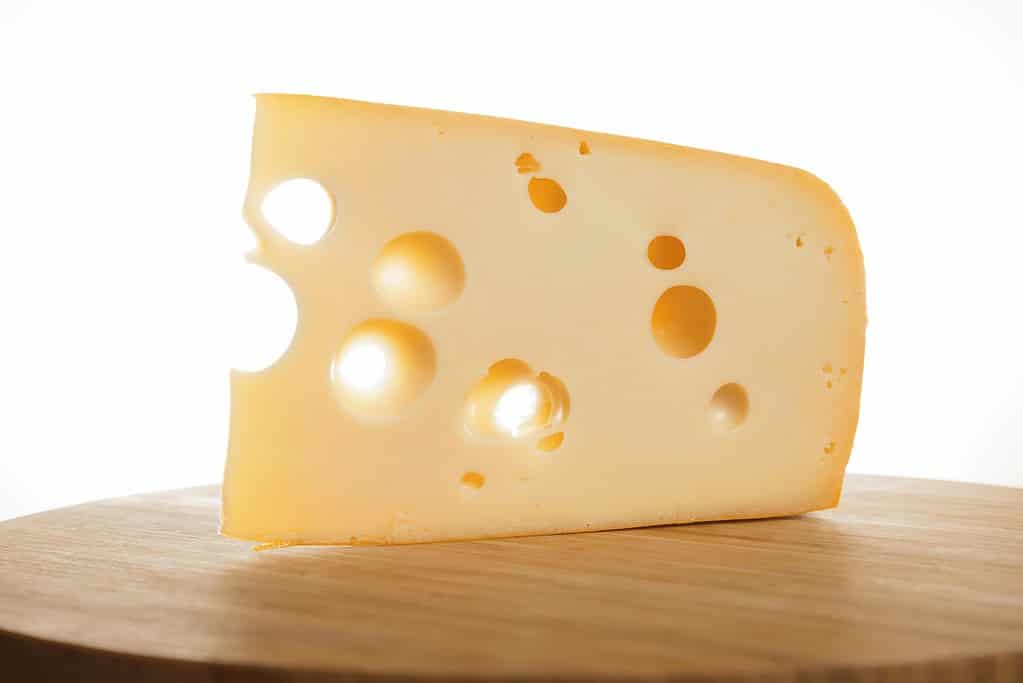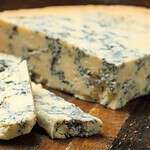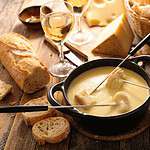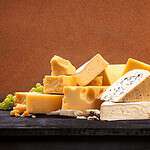Swiss cheese is famed for its distinctive holes, which are also known as eyes. These eyes are not just for aesthetic appeal; they reveal a lot about the cheese-making process. The development of these holes is a result of natural bacterial action during the fermentation of the cheese. These bacteria consume lactic acid and release carbon dioxide gas, which gradually forms the bubbles that become the characteristic holes of Swiss cheese.

The size and number of eyes in Swiss cheese are not accidental but are controlled by specific factors during its production. Cheese makers manage temperature, acidity, and the time allotted for the cheese to age, all of which play a vital role in the development of the eyes. This careful regulation ensures that each batch of Swiss cheese has the right texture and flavor, making it a beloved ingredient in various culinary dishes around the world.
Key Takeaways
- Swiss cheese is known for its eyes, which are formed by carbon dioxide gas during fermentation.
- The hole formation is influenced by controlled factors like temperature, acidity, and aging time in cheese-making.
- Swiss cheese’s unique characteristics make it a popular choice in diverse culinary cultures.
Cheese Origins and Varieties

In this section, we explore the rich history of Swiss cheese and the assortment of types that contribute to its fame.
The History of Swiss Cheese
Swiss cheese, particularly Emmental which is often considered the original Swiss cheese, originated in the canton of Bern in the Alps during the 15th century. Its distinctive holes, or “eyes,” are a result of the fermentation process that involves bacteria consuming the lactic acid and releasing carbon dioxide gas. This cheese-making tradition has been refined and maintained, echoing the taste and craftsmanship of Switzerland’s dairy culture for centuries.
Types of Swiss Cheese
- Emmental: Features a nutty, sweet flavor with characteristic large holes.
- Gruyère: Known for a creamy and slightly nutty flavor, Gruyère lacks the holes found in other Swiss varieties.
- Appenzeller: Hailing from the Appenzell region, it’s spicy and herbal, with tiny holes.
- Baby Swiss: A milder cheese with smaller holes and a buttery, creamy texture.
Other varieties that are Swiss-inspired but not originated from Switzerland include:
- Jarlsberg: Originating from Norway, this cheese is similar to Swiss types with large holes and a mild flavor.
- Cheddar, Gouda: Not Swiss varieties, but they represent the diversity in cheese-making; Cheddar from England and Gouda from the Netherlands, each without the holes associated with Swiss cheeses.
Scientific Process Behind Cheese Formation
When we make cheese, specific bacteria play a crucial role, not only in flavor development but also in creating the characteristic holes seen in Swiss cheese. Let’s examine the scientific intricacies involved in cheese formation, particularly that of Swiss cheese.
Role of Bacteria in Cheese-Making
In cheese production, we rely on bacteria to kickstart the process of turning milk into cheese. These bacteria are responsible for fermenting lactose, the sugar in milk, to lactic acid. This acidification of the milk results in the formation of curd, which is the solid part of the milk that is separated from the liquid whey. A crucial bacterium in Swiss cheese is Propionibacterium freudenreichii (formerly known as P. shermanii). This bacterium is introduced to milk after the primary fermentation has taken place. Its role extends beyond simply fermenting lactose; it is instrumental in creating the flavors unique to Swiss cheese during the aging process.
Formation of Holes (‘Eyes’)
Our Swiss cheese is known for its holes, or ‘eyes,’ which are the result of gas production. These holes are created by the release of carbon dioxide (CO2) gas. During the cheese aging process, P. freudenreichii consumes the lactic acid present in the cheese and releases carbon dioxide. As the bacteria continue to consume the lactic acid, the amount of carbon dioxide increases, which eventually forms bubbles trapped within the cheese curd. These bubbles grow and create the characteristic holes that we see in the final product.
Influence of Temperature on Cheese Maturation
Temperature plays a critical role in the aging process of cheese. During the maturation of Swiss cheese, temperatures are carefully controlled to optimize the growth of P. freudenreichii and the resulting gas production. A slightly warmer temperature is generally favored initially to promote the activity of the bacteria, followed by a cooler temperature to slow down the process and allow the cheese to develop its flavor and texture gradually. The control of temperature ensures that gas forms at the right rate and that the holes in the cheese are the desired size and distribution.
Cheese-Making Techniques

In our approach to creating Swiss cheese, we focus on two essential steps which involve curd processing and aging, followed by rind formation and brining. These techniques play significant roles in developing the cheese’s unique characteristics.
Curd Processing and Aging
We begin our cheese-making process by warming the milk and adding bacteria cultures along with rennet, which causes the milk to coagulate into curds. The curds are then cut and stirred to promote whey separation. Here’s a critical point: during this phase, the temperature and handling of the curds are meticulously controlled to ensure the perfect texture for Swiss cheese.
Aging Process:
- In initial stages: we keep the cheese at a warmer temperature to invite bacteria that produce carbon dioxide gas.
- As carbon dioxide is released, it forms bubbles within the curds, which eventually become the characteristic holes or ‘eyes’ as the cheese ages.
- The duration of aging can last from a few months to several years, depending on the desired flavor profile and texture.
During the aging period, we regularly turn and inspect the cheeses to ensure even ripening and the development of a uniform flavor and appearance.
Rind Formation and Brining
Once the curd is set into the cheese mold and pressed, we move to the next phase — creating the rind.
Brine Bath:
- The pressed cheese wheels are submerged in a saltwater brine for several days.
- The concentration of the brine, and the duration for which the cheese is soaked, are meticulously calculated to contribute to the cheese’s flavor and to inhibit unwanted bacteria growth.
The formation of the rind is a natural byproduct of the brine treatment and drying period that follows. Our cheesemakers ensure that the rind forms correctly by controlling humidity and temperature conditions in the aging rooms. Over time, the rind not only adds to the character of the Swiss cheese, but also plays a role in protecting the cheese during its aging process.
Factors Affecting the Characteristics of Swiss Cheese

In our examination of Swiss cheese characteristics, we focus on the elements crucial to its distinctive appearance and longevity. Two primary areas of interest are the hay particulates linked to the formation of holes, often referred to as ‘eyes’, and the impact of maturation and storage conditions on the cheese’s overall quality.
Hay Particles and the ‘Hole Defect’
Traditionally, the appearance of holes in Swiss cheese was believed to be caused by hay particles falling into the milk during the cheese-making process. These particles could introduce bacteria that generate gases, leading to the formation of holes or ‘eyes’ during fermentation:
- Presence of Hay Particles: Initiate bacterial activity.
- Gas Production: Propionic acid bacteria metabolize the lactic acid produced during fermentation, releasing carbon dioxide gas.
- Formation of Holes: This gas cannot escape from the thickening curd and forms bubbles, which become the cheese’s characteristic holes.
Temperature during the cheese-making process affects the size and distribution of these holes. It is essential that:
- Temperature is accurately controlled to ensure consistent hole formation throughout the cheese block.
- Desired Hole Outcome: To achieve the classic Swiss cheese holes, maintaining the right temperature is key, as it influences bacterial activity and gas production.
Role of Ripening Duration and Storage
The ripening process is essential in developing the flavor and determining the shelf life of Swiss cheese. The following are significant:
- Ripening Duration: Longer ripening periods allow for the full development of flavor and texture but can also impact the hole formation.
- Short-Term Ripening: Can lead to smaller, less-developed ‘eyes.’
- Extended Ripening: Contributes to larger ‘eyes’ and a more pronounced flavor characteristic of aged Swiss cheese.
- Storage: Proper storage conditions are necessary to prolong the cheese’s shelf life maintaining the desired characteristics.
- Temperature: Must be consistent to prevent the spoilage of the cheese and preserve its shape and texture.
- Humidity: Regulated humidity levels ensure that the cheese does not dry out, affecting both its flavor profile and the structural integrity of the holes.
By attending to these details, we create an ideal environment for the cheese to develop its taste and structural composition, including the holes synonymous with Swiss cheese, without causing ‘defects’. Maintaining an optimal balance between ripening and storage condition is integral to the achievement of the cheese’s long shelf life and specific qualities.
The Cheese Industry and Standards

In the cheese industry, stringent standards and technological innovations ensure the production of consistent and high-quality Swiss cheese. We observe strict regulation and significant research efforts to maintain these standards.
Regulation and Quality Control by Authorities
The Department of Agriculture and other authoritative bodies like Agroscope, a leading Swiss agricultural institute, play critical roles in regulation. They establish standards that producers must adhere to, which include the quality of milk used and the conditions under which cheese is made and aged.
- USDA (United States Department of Agriculture) standards are particularly influential globally and often serve as a benchmark for quality.
The agencies oversee the entire cheese-making process, from milk production to packaging, conducting regular inspections to ensure compliance. Compliance with these standards is mandatory to ensure that only high-quality products reach consumers.
Research and Technological Advancements in Cheese Production
Our understanding of cheese production has grown exponentially, largely due to ongoing research and technological advancements. The Center for Dairy Research at the University of Wisconsin stands out as a hub for dairy science innovation.
- Researchers leverage tools such as the CT scanner to study cheese structure, including hole formation.
This technology helps scientists understand the fermentation process better and thus allows for the improvement of cheese quality and texture. By retaining a strong emphasis on research, the cheese industry continues to evolve, elevating both the science and art of cheese-making.
Swiss Cheese in Culinary Culture
Swiss cheese is a versatile ingredient prominent in various dishes and beverage pairings. It adds a unique flavor and texture that complements many recipes and drinks.
Popular Swiss Cheese Dishes
Swiss cheese is featured in numerous iconic dishes. We often see it on sandwiches like the classic Cuban sandwich and the Reuben sandwich, where its melting qualities and distinct tangy flavor enhance the overall taste. It’s an essential ingredient in the French onion soup, adding a creamy, rich layer on top. For those who enjoy a heartier meal, the mushroom and Swiss burger combines melted Swiss cheese with savory grilled mushrooms, creating a delightful blend of flavors.
Breakfast options include the ham and Swiss omelet, a staple that marries the subtle taste of Swiss cheese with the savoriness of ham. The muffuletta, a sandwich from New Orleans, layers Swiss cheese with a variety of meats and olive salad. Those looking for classic comfort food might opt for a rich and satisfying macaroni and cheese made with Swiss for a sharper twist, or a quiche, where Swiss cheese’s meltability adds a smooth consistency.
For more elaborate gatherings, cheese fondue in which Swiss cheese plays a starring role, becomes a communal dining experience, allowing guests to dip and share. Lastly, the refined taste of Swiss cheese is a perfect match for chicken cordon bleu, a dish where it pairs with ham and chicken for a sumptuous entrée.
Pairing with Beverages
When it comes to beverages, Swiss cheese has some exemplary companions.
-
Beer: Swiss cheese pairs beautifully with a variety of beers. A light lager can complement a ham and Swiss sandwich, while an amber ale can stand up to the strong flavors of a Reuben sandwich.
-
White Wine: For those who prefer wine, Swiss cheese and white wine make an excellent match. A crisp Chardonnay pairs well with a chicken cordon bleu, and the acidic bite of a Sauvignon Blanc is a perfect match for a rich fondue.
Here is a simple pairing guide:
| Dish | Recommended Beverage |
|---|---|
| Cuban Sandwich | Light Lager |
| Reuben Sandwich | Amber Ale |
| French Onion Soup | Chardonnay |
| Mushroom and Swiss Burger | Pale Ale |
| Ham and Swiss Omelet | Sparkling White Wine |
| Chicken Cordon Bleu | Chardonnay or Rosé |
| Cheese Fondue | Sauvignon Blanc |
We integrate Swiss cheese into our dishes and drink pairings with confidence and creativity, always discovering new ways to let its distinct character shine through.
Cheese Production in the United States
In our exploration of cheese production in the United States, we must note that the nation stands as one of the largest cheese producers worldwide with certain states leading the charge.
Major Cheese-Producing States
Wisconsin is prominently known as “America’s Dairyland,” a testament to its significant role in cheese production. According to the U.S. Department of Agriculture and Dairy Farmers of Wisconsin, the state not only leads in sheer volume but also in the variety of cheeses produced.
California follows closely, utilizing its vast dairy farms to produce large quantities of cheese, with an emphasis on mozzarella and cheddar.
Moving eastward, New York figures as a key player as well, with a strong presence of Italian-style and specialty cheeses.
Idaho, known for its favorable dairy farming conditions, has been steadily growing as a cheese-producing state, particularly when it comes to cheddar and Monterey Jack.
In the Midwest, Ohio plays its part with a significant output of Swiss cheese, contributing to the cultural and economic fabric of the state’s dairy industry.
Down south, Texas has been building up its cheese production capabilities, diversifying its agricultural industry to cater to the increasing demand for cheese.
Lastly, Utah has carved out a niche for itself with a focus on lower-volume artisanal cheese production, leveraging local milk sources to support a growing industry.
All these states contribute to a robust national cheese market, supported by a network of dairy farmers and influenced by the regulations and research of entities like the U.S. Department of Agriculture. Through collective effort and expertise, we ensure the sustainment and growth of cheese production across the United States.
Frequently Asked Questions
We have compiled a list of frequently asked questions to offer clear insights into the fascinating process behind Swiss cheese and its unique characteristics.
How are the holes in Swiss cheese formed during its production?
The holes in Swiss cheese, known as eyes, are created by carbon dioxide gas bubbles. These bubbles form during the fermentation process when bacteria consume lactic acid and release the gas.
What factors contribute to the size of the holes in Swiss cheese?
The size of the holes in Swiss cheese is influenced by the temperature and duration of the cheese aging process, as well as the types of bacteria used in fermentation. Variances in these factors result in different hole sizes.
Can you find holes similar to those in Swiss cheese in other types of cheese?
Yes, other semi-hard cheeses, like Jarlsberg and Leerdammer, also exhibit holes similar to Swiss cheese. These cheeses go through a similar fermentation process, resulting in the characteristic holes.
What influences the flavor profile of Swiss cheese?
The flavor profile of Swiss cheese is affected by the specific strains of bacteria used during fermentation. The aging time also plays a crucial role; longer aged cheeses generally have a more robust flavor.
What is the name for Swiss cheese varieties that lack the characteristic holes?
Swiss cheese varieties without the characteristic holes are often known as “blind” cheeses. An example is Lacy Swiss, which has a similar flavor but a denser structure.
What do the holes in Swiss cheese signify in terms of cheese quality and aging process?
In Swiss cheese, the size and distribution of the holes can indicate a well-aged cheese under proper conditions. Evenly dispersed, well-sized eyes generally signify a cheese of high quality.






